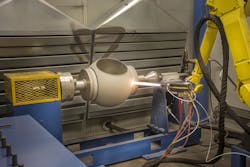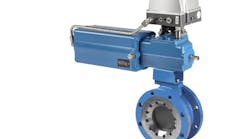Part 1 of this series appeared in the August issue of Flow Control. It discussed the valve actuator requirements of the coking process, a refinery unit operation that upgrades material called bottoms from the atmospheric or vacuum distillation column into higher-value products. The end product is petroleum coke, a coal-like material. Part 2 explores the available design options for ball valves in coker service, and how to select the correct one.
When selecting valves for coker application, it is important to evaluate the valve manufacturer’s installation history, maintenance support engineering staff and automation support. Product factors to consider are valve sealing (for example, sturdy bellows maintain constant ball-to-seat contact, preventing buildup of coke on the sealing surfaces) and how quickly and easily finished full bore and trim can be replaced. Is a large range of valve sizes and pressure class available? Is exotic material available such as A217Gr C5 and C12 and A351Gr CF8M, CF8C and WCB/LCB for lower temperature applications? Beyond the manufacturer’s experience in coker valve applications, other considerations when designing and selecting valves include:
- Required function
- Service conditions
- Fluid type and condition
- Fluid characteristics
- Frequency of operation
- Isolation requirements
- Maintenance requirements
- Environmental considerations
- Past experience in comparable conditions
- Flow path identification and geometry of flow path
- Weight and size
- Cost
This article explores trunnion-mounted ball valves in two-way, three-way and multiports used in coker valve design.
Common design problems
A solids-proof style valve, i.e., the embedding of abrasive particles in seat materials, will abrade the ball surface. These grooves/scratches will cause leak paths which further damage surfaces. The solution is to use metal-to-metal seating, typically a hard-surfaced ball in nickel-boride or tungsten carbide versus a proven wear surface on the seats (such as Stellite 6). The ball sphericity is critical. This means that balls must be ground on a machine that actually generates spheres. If nickel-boride is used, the sphere must first be ground, then coated. If tungsten carbide is used, the steps are pre-machining, coating, rough/final machining and then grinding.
Clogging of springs cavities, spring recesses, bearings, seat spool ODs and stem-sealing areas are other issues. The solutions are to address each potential area with detailed solids exclusion designs. Neglecting to do so will cause premature failure. Once bearings are clogged — or the annular spaces around a seat spool become clogged or particulates find their way between moving components or support bearings — many problems occur. At the least, valve leakage will increase or increased torque will make the valve hard to operate — or perhaps inoperable.
Image courtesy of Tisoro Refining
Solids-proof design advantages
Solids-proof design features a live-loaded, self-cleaning seat module and an accurately matched ball valve. Even with heavy solids loading, the rotation of a trunnion-mounted ball valve on its own axis ensures its ability to freely travel between the open and closed positions. As a result, solids do not have to be displaced laterally. Other advantages of this design include:
- The ball and stem axis stays in a fixed position.
- Metal seats are superior to soft-seated inserts in severe service and abrasive environments.
- Seat spool assemblies are preloaded and continuously pressurized against the ball.
- One-piece wave springs are utilized in place of multiple small coil springs. The wave springs are
isolated from pipeline media to avoid clogging. - Ball spheres are precision-machined, ground and hard-coated to a precise, controlled thickness.
- The seat surfaces and the ball sphere are matched accurately to provide a tight metal-to-metal seal.
- Mating surfaces are protected and matched to the following options: tungsten carbide against tungsten carbide; Stellite 6 against tungsten carbide; Stellite 6 against nickel boride.
- Seat and body cavity spaces are protected from particulates via multiple barrier systems. Seats have a scraper design, cleaning the ball surface of any particulate during ball travel.
- Sealant injection is included on each seat with giant button-head fittings with caps. Positions are at 3 and 9 o’clock. The sealant is introduced into the annular groove at the rear of the seat spool. Then, via a pattern of holes, it is introduced to a groove in the face of the seal adjacent to the ID of the inner scraper seat.
- The bearing and sealing surfaces protected include trunnion bearings; thrust bearings; spacer bearings (to ensure accurate alignment); and stem seal areas (to prevent invasion of particulates).
- All bearings, including sleeve bearings, have seals to prevent particulate ingress. Bearings are hard-surfaced with nickel boride. The same coating is used on the stem. Nickel boride is used
because it is as hard as tungsten carbide but has a low coefficient of friction to prevent galling. - Actuation with an electric actuator will utilize a double-enveloping worm design gear. The highly efficient actuator selection will produce at least two times the torque output as a standard worm gear. The use of existing actuation with highly efficient worm gear design is beneficial in case of replacement on the existing line.
Stem coupling design benefits
Coker applications can also benefit from a stem coupling design. This design performs key functions such as protection against over-torqueing of stem, protection of the actuator components and protection against an unintentional switch into bypass.
In this design, steam purges to the bellows and body area to ensure the valve cavities are kept free of coke buildup. A lantern ring with steam block and extra-deep stuffing box minimizes the risk of leakage occurring through the packing chamber.
The sturdy one-piece ball and stem provide optimal strength and are well-suited to applications where fouling caused by coke fines is a concern. The one-piece design prevents problems generally associated with the more conventional two-piece ball and stem, which is highly susceptible to solids buildup in the ball-stem joint and an increase in operating torques.
Seat design to self-scrape coke buildup from the surface of the ball during each cycle is another advantage of this design. Seats are hard-faced with the high-velocity fuel thermal method to ensure a long, trouble-free service life.
Strong bellows offer a unique seat-loading design, which maintains the floating seats in constant contact with the ball and ensures a positive seal.
Electric, hydraulic or pneumatic actuator automation support includes a large torque safety factor that ensures the valve will cycle under the most stringent conditions. When selecting actuators, pay special attention to the coker deck environment.
Valve maintenance concerns include energy conservation, process stability, freeze protection, corrosion inspection, environmental protection and simplified valve maintenance.
Valves of this design are removable and reusable. They are engineered to have thermal efficiency as high as 98 percent, exceptional service life, simplified valve access, tool-free installation, a rapid return on investment period, process stability/reliability, reduced environmental emissions and improved health and safety for operations and maintenance personnel.
Butterfly/ball valves
Butterfly/ball valves (for example, ring types) are used in coker back-pressure control. In one case study, the end user required the use of this type of valve only when shorter cycle times required quicker drum back-warming. The end user could not justify the high pressure drop across the valves with increased efforts to liquid yield. The user required a valve with good throttling characteristics. Because these valves are installed in high-pressure applications with highly erosive and sometimes corrosive reclaimed water (used to drill the coke out of the drum) valve life can be significantly shortened.
Intrinsically safe and SIL-rated components are key features to look for in these types of valves. A butterfly/ball valve required in this application may have no seats, so it is actually a throttling valve. As a result, it does not require a mechanical stop to avoid full closure and the resulting drum overpressurization. Another feature is that steam purges to the bellows and body area ensure the valve cavities are kept free of coke buildup. In the maximum obstruction position, the valve provides a pressure drop equal to a butterfly valve disc set open at 15 degrees.
When selecting actuators, pay special attention to the coker deck environment. The electric, hydraulic or pneumatic actuator is selected in function of coker service. A large torque safety factor ensures the valve will cycle under the most stringent conditions. To ensure long, leak-free, reliable operation, all valve wetted parts should be hard-faced and bidirectional.
Other considerations
Look for a fully automated switch valve controlled from a local control panel with interlocks to the inlet transfer line valves to avoid dead-ending of the pump. This provides the automated operation of valves with a minimum risk.
Look for modulating back-pressure control valves with full feedback capability. A local control panel can operate each of these valves, This panel provides safety interlocks that are either hardwired to the actuator, have a dynamic stability control system or function through a stand-alone programmable logic controller (PLC) for more comprehensive controls and interlocking.
What to look for from a valve manufacturer
When selecting a valve manufacturer for coker service, look for a few key features. Find out if the engineering staff has expertise in critical applications and who can use advanced software applications including stress analysis and finite element analysis, computational fluid dynamics, failure mode effects and diagnostic analysis. These programs can be used to meet the needs of system designers for reliability data, integration of the valve into a safety instrumented function, partial valve stroke test, 3D solid-modeling, system upgrades, flow analysis, weak link analysis, root cause failure analysis, commissioning, troubleshooting, application engineering, custom testing and test data analysis (nondestructive, X-ray, ultrasonic, etc.). These programs can also design superior quality valves that meet the most demanding performance requirements.
Ask about the manufacturer’s research and development facilities. Ideally, the company should have steam boilers, superheaters, flow loops, cryo test benches, and emissions testing capabilities in addition to a good partnership with major engineering and end users to develop innovative solutions. Manufacturers should handle every detail of these complex integrations and offer a full factory acceptance test which considers valves, actuators, panels and PLCs as a system to ensure proper functioning.
Field engineers should perform a site acceptance test and assist in unit commissioning and startup.
The manufacturer should provide training for operators and maintenance personnel to implement a preventive maintenance program that includes periodic torque verifications, steam evaluations and general valve performance. These programs already implemented in user plants can substantially lower turnaround costs and significantly reduce the possibility of unscheduled turnarounds.
Partner with a manufacturer that provides assistance during the preparation of major turnaround by preparing an assessment of the valves, actuators and expected spare parts requirements. For OEM spare part and tool support, the manufacturer should recommend spare parts. For new projects, it should advise on spare part interchangeability reports.
Lastly, the manufacturer should assess local service shop capabilities and work with the end user to prepare additional service shop capabilities, if required. These services ensure all of the correct materials are available and that approved and knowledgeable personnel are on hand for the turnaround. Maintenance training courses on the entire range of valves used in coker applications including latest and proper maintenance techniques are essential.
Gobind Khiani is a professional engineer with more than 21 years of experience in the petroleum industry. He has served as lead engineer, in engineering and project management roles, for operating companies and engineering, procurement and construction companies. Khiani has a bachelor’s degree from University of Pune, India, and a master’s in engineering., from the University of Calgary, Alberta. His current role is director – I, design engineering, on projects with Fluor Canada Ltd.



